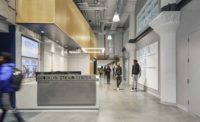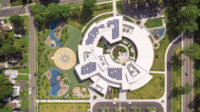'This building has light, energy, and life!' exclaims Dunbar Senior High School's principal Stephen Jackson. 'I love it, love it, love it!' Jackson is raving about the 280,000-square-foot brick, glass, and steel structure that opened in August in the Truxton Circle section of Northwest Washington, D.C. It will soon accommodate 1,100 students, but for now a few more than 600 are populating its halls. The public high school, designed by Perkins Eastman in association with Moody Nolan, is a four-story facility with an L-shaped plan (one wing for academics, the other'a chunkier block'for sports and arts), partly enclosing an athletic field.
The majestically modern edifice is the third incarnation of Dunbar on this site. In 1870, Dunbar was founded as the Preparatory High School for Colored Youth, the first of its kind in the United States, in a church basement at 15th and R streets. By 1916, the school took the name of the poet Paul Laurence Dunbar and moved into a new Tudor-style red-brick structure in the present spot. Recognized for its intense academic curriculum, Dunbar thrived. Its alumni include Congresswoman Eleanor Holmes Norton, Brigadier General Elmer Brooks, and current D.C. mayor, Vincent C. Gray.
'The 1916 school was a stately building, designed with a flair that enhanced its tremendous educational mission,' says Mayor Gray. Eventually, however, the facility needed modernization. In spite of a lengthy battle fought by preservationists to keep the venerated structure, it was torn down in 1977. Its replacement, designed by a prominent local African American architectural firm, Bryant & Bryant, occupied the northwest corner of the site. Both its concrete Brutalist-modern style and the open'plan method of teaching reflected prevailing design and educational thinking of the time. The paucity of windows was also a response to the growing violence in the inner city. Says Gray, 'This Dunbar looked like a prison.' Jackson adds, 'It had lots of hiding places, and it was cramped. As research shows, crowding people together creates tension and aggressive behavior.'
Around 2000, it became clear that both architecture and education were suffering. The Dunbar Alumni Federation pressed for a brand-new facility'one that would incorporate features of the historic 1916 structure, including an 'armory' like the one where high-school Reserve Officers Training Corps (ROTC) practice once was held and where students could hang out.
The architects responded with a design distinguished by articulated facades, deeply profiled mullions, louvers, cornice-like canopies, and statuesque piers. 'We wanted to create a sense of scale, especially on the academic wing,' says Sean O'Donnell, principal in charge at Perkins Eastman, 'and express the structure's varying functions on the exterior.'
The new school, built on the southeast corner of the site formerly occupied by the 1916 building, does not feature its dark-red brick: instead, the architects devised a syncopated pattern of multitonal shades of beige. While this seems a bit jazzy, the mayor (who still has a brick from the 1916 school) calls it 'aesthetically pleasing, with a dignified look.'
The brick alternates on the exterior with a deep-blue-gray aluminum composite material for trim and panels, all of which continue into the atrium'or, as it is deferentially called, the 'armory.' The armory isn't what one might expect: a food court occupies its east end, and a wide stair leads to a bridge that diagonally crosses the main space to the south-side mezzanine. There, a sunlit senior lounge and an enclosed media room are endowed with the stately proportions and art deco aura reminiscent of Radio City Music Hall's ancillary spaces. Heightening its cultural image and connection to the community is a museum below, next to the entrance, where an exhibition proclaims the contributions of illustrious alumni.
In terms of its educational goals, Dunbar has created four 'academies.' After the ninth grade (the first academy), students choose among three, whose curricula are education; business, law, and public policy; or pre-engineering. Those involved in pre-engineering 'will find features in the building that correlate with their studies,' says O'Donnell, who is seeking a LEED Platinum rating for the new structure. So far, Dunbar has installed 372 geothermal wells under the football field, with more going below the just-demolished 1978 school. Photovoltaic panels (1,750) are being mounted on the new roof, and there are two 20,000-gallon cisterns for stormwater reclamation. Other green measures involve using low-E glass and low-VOC materials, plus recycling detritus from the 1978 building in off-site projects.
Now, only a few months after its opening, Dunbar appears phenomenally successful and, as Jackson proudly contends, filled with energy. Whether or not architecture can once again be seen as helping education may have to wait until the current crop of ninth graders graduates. For his part, Jackson predicts: 'The students definitely will do better in this building.'
PeopleClient: DC Department of General Services/District of Columbia Public Schools Owner: DC Department of General Services/District of Columbia Public Schools
Architect:
Personnel in architect's firm who should receive special credit:
Architect of record: Associate architect(s): Moody Nolan (please also refer above)
Engineers: Mechanical, Electrical, Plumbing, Fire Protection: Setty & Associates International Civil: AMT, LLC
Consultant(s): Acoustical: Shen Milsom Wilke
Other: Acoustics, Audio Visual, Telecommunications, and Security: Shen Milsom Wilke Aquatic Design: Aquatic Design Group LEED: Sustainable Design Consulting General contractor: Smoot/Gilbane, a joint venture
Photographer(s): Size: 280,000 square feet Total construction cost: $128 million (total) Completion date: August 2013 |
Products
Structural system Manufacturer of any structural components unique to this project: Maclloy Rods
Exterior cladding Metal Panels: Reynobond Metal/glass curtain wall: YKK Precast concrete: Southside Precast Moisture barrier: BASF Curtain wall: YKK
Roofing
Windows
Glazing Skylights: Kalwall Insulated-panel or plastic glazing: See skylight above
Doors Metal doors: Steelcraft Wood doors: Eggers Industries Fire-control doors, security grilles: Overhead Door
Hardware Closers: Rixson, LCN Exit devices: Von Duprin Pulls: Ives, Von Duprin Security devices: Von Duprin
Interior finishes Suspension grid: Armstrong Demountable partitions: Modernfold Cabinetwork and custom woodwork: Leonard Peterson, Ashland Paints and stains: PPG Paneling: Rulon Plastic laminate: Wilsonart Solid surfacing: IceStone Floor and wall tile: Daltile, floor and wall tile Resilient flooring: Wels Sheet, Forbo, Johnsonite, Ecosurface Carpet: Interface
Furnishings Reception furniture: KI, Dauphin Fixed seating: Irwin Chairs: KI, Dauphin Tables: KI
Lighting Downlights: Prescolite Exterior: Lite Control, Musco Dimming System or other lighting controls: Lutron
Conveyance
Plumbing
Energy Photovoltaic system: Solarworld, Uni-solar |



















Post a comment to this article
Report Abusive Comment